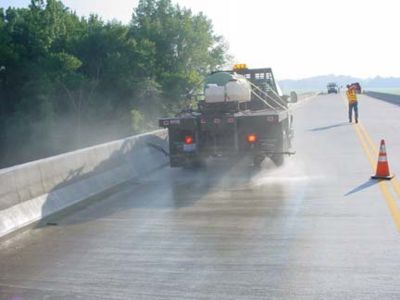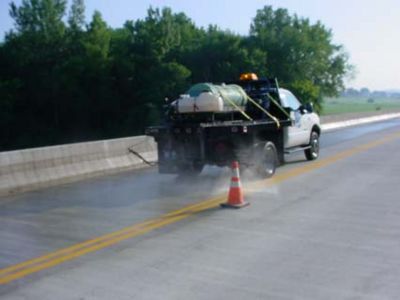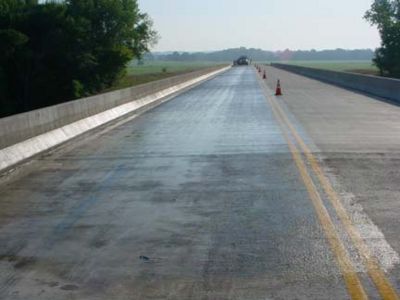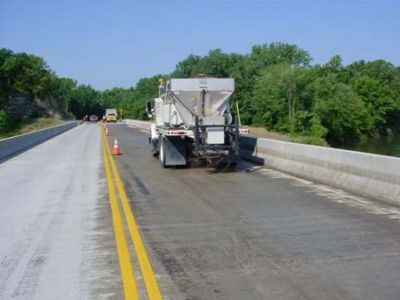771.16 Penetrating Concrete Sealer - Silane
| Code: R322 |
Linseed oil treatment reduces the intrusion of water and chlorides into the deck surface on bridges with B-2, low slump, or silica fume concrete decks. The work should be performed in hot, dry weather such as in July and August.
| Bridge Deck, Sealer |
| Summary 2000 |
| Report 2007 |
| See also: Innovation Library |
Materials
Boiled linseed oil, mineral spirits and sand.
General Note: The linseed oil penetrates the fine pores in the deck and greatly reduces the permeability/porosity of the deck. This provides freeze/thaw protection and reduces the chloride penetration into the deck. The linseed oil treatment is a total surface treatment, not a crack treatment. Newly constructed bridges receive the first application of linseed oil by the contractor upon completion. Maintenance personnel apply a second treatment about one year later. It has been shown that additional treatment after the second coat offer little additional benefit as only a small amount of the linseed oil penetrates the surface. Bridges several years old that show signs of scaling may benefit from an additional application of linseed oil. Should not be applied to worn or polished bridge decks.
Bridges to receive an application of linseed oil are identified by GHQ and district bridge inspection personnel. A list is created from which material quantities can be determined. Linseed oil and mineral spirits are ordered on a statewide purchase.
Procedures
1. The deck should be completely clean and dry. Any loose dirt or dust should be blown off the deck immediately prior to the application of the mixture.
2. The material is applied using a sprayer or a distributor that has been thoroughly cleaned out. See table below for the proper application rate. The mixture is applied to half the deck at a time. The inside face and top of the barrier curbs shall also be treated. Traffic must be stopped while the material is being applied to prevent over spray on vehicles.
| Deck Surface Concrete | Application Rate |
|---|---|
| Silica Fume | 0.02 gal/yd2 |
| B-2 | 0.03 gal/yd2 |
| Low Slump | 0.02 gal/yd2 |
| Mixture is 50% linseed oil and 50% mineral spirits. | |
3. Traffic must not be allowed on the wetted, slippery surface. The mixture is allowed to penetrate and dry. Areas that dry quickly should be sprayed with the hand sprayer to maintain an even coat. Puddles should be squeegeed to assist drying. Drying time is dependent on application rate, temperature, sunshine, humidity, and wind. Apply sand to surface to improve short-term skid resistance.
4. Traffic is allowed on the treated surface only when the surface is dry and traffic does not pick up the linseed oil.
5. Repeat treatment to the other half of the deck.
6. Excess sand shall be removed when the deck is completely dry.
Safety
The mineral spirits and linseed oil mixture has a low flash point. Care must be exercised to prevent igniting the mixture by sparks, open flame or other means. In no case should the mixture be heated in a distributor. Spray must be controlled so not to get on passing vehicles or adjacent property.



